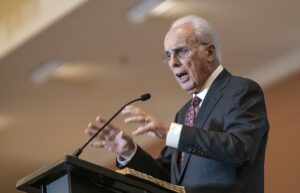
NASHVILLE, Tenn. (BP)–“We rarely preach it,” said Barbara O’Chester, and “barely teach it and simply don’t practice it.”
The church needs to do a better job of uplifting God’s plan for marriage to the next generation, said O’Chester, director of The Great Hills Retreat Ministry, Austin, Texas, and other Southern Baptist experts in family life concerns in response to the annual report recently released from the National Marriage Project, an initiative of Rutgers University and several private organizations.
The National Marriage Project report stated, among various findings, that “surveys of teen attitudes over the past few decades point to a growing disparity [about marriage]. The desire of teenagers for a long-term marriage is greater than ever, but girls, especially, have become more pessimistic about ever being able to have such a marriage, and both boys and girls have become much more accepting of alternatives to marriage” such as cohabitation and single parenthood.
Jon Walker, editor of HomeLife magazine of LifeWay Christian Resources, noted, “Statistics tell us the divorce rate inside the church is the same as outside. No wonder these young people feel this way. They look around and there is hardly anybody they can emulate. We Christians are acting like everyone else.”
Anthony Jordan, executive director of the Baptist General Convention of Oklahoma, agreed. “Our state is second in the nation in the number of divorces, and 75 percent of the population is Baptist,” said Jordan, who also chaired the committee that drafted a family article added to the SBC’s Baptist Faith and Message confessional statement last year.
“These teenagers intuitively know marriage is the best thing and they long for that intimacy,” Jordan said, “but they don’t have a good model in front of them.”
Why not? Because the church has accepted the world’s view of marriage, the family life experts say, and thus the church is reaping the kind of marriages the world has.
“There’s a myth of Mr. Right and Miss Right,” Walker said. “The world believes, and Hollywood promotes, the idea that you have to find the absolutely most perfect person, and that is what makes your marriage perfect. We, as a church, have bought into this myth of eternal romantic love, but it doesn’t exist. Couples marry, come to realize this, and they bail out, continuing the search for the perfect spouse.
“But the reality is, we are meant for those initial fantasies to fall apart. God designed us that way so that when the infatuation wears off, we will come to him for the true reality,” Walker said. “Marriage can be exciting. It’s a unique relationship where you can get to know one human being better than any other human being in the world.”
Because the church has adopted the world’s view of the perfect spouse, it is often unequipped to teach the next generation about God’s true plan for marriage. “Even ministers’ marriages are failing at an alarming rate,” O’Chester said. “Therefore, we’re doing a poor job of teaching the future generations, and the present one. As the body of Christ, we cannot lower the standard for marriage and raising children.”
But how to uphold it? Richard Ross, who helped initiate the “True Love Waits” emphasis on abstinence until marriage, said mentoring is the key to a brighter, more hopeful future for marriage.
“The church needs to surround these teenagers with youth leaders and church members, both young and old, who can model happy, stable marriages. Intergenerational events are essential so teenagers can watch lifetime marriages close up.”
The experts recommend assigning engaged couples an older, mature married couple within their local church as mentors throughout their first year of marriage. “Real life, accessible role models are the most effective,” O’Chester said.
Walker agreed, and added education and training also are important. “We need to teach teenagers, and our young married couples, relational skills — how to communicate, how to fight fairly. A lot of churches host marriage conferences, but teenagers don’t go to them. Ongoing, preventative programs are needed in every local church.”
As executive director of the Baptist General Convention of Oklahoma, Anthony Jordan has used his convention’s influence to begin a statewide marriage initiative.
“Our state convention has added a marriage and family specialist to its staff, and we are preparing to ask all Baptist pastors in Oklahoma to sign a covenant that they will not marry a couple without pre-martial counseling, a four-month waiting period and a yearlong mentoring relationship. We are going to ask other faith groups to join us as well.”
Without such education and mentoring initiatives to uplift God’s plan for marriage to the Christian and secular worlds, the experts believe the future will be no brighter than the present.
“We as a society are reaping what we have sown,” Walker said. “We have for years downgraded marriage, promoted no-fault divorces and said that divorce does not affect children. Reports like this from the National Marriage Project give us statistical information that divorce does affect children, if for no other reason than it formulates a negative view of what marriage is. Every divorce that occurs in this country diminishes the marriages of us all.”
But the good news is that even though the nation’s teenagers are pessimistic about marriage, they can be given the skills and support necessary to succeed. “All we have to do is follow the Word of God,” Jordan said. “It’s time for us to go back to our biblical roots and do family God’s way.”
For a copy of the full report, visit the National Marriage Project’s Internet site at https://marriage.rutgers.edu/state.html.
Other findings from the project’s annual report, released in early July, include:
— Marriage trends in the United States over the past four decades indicate that Americans have become less likely to marry, and fewer of those who do marry have marriages they consider to be “very happy.”
— The American divorce rate today is more than twice that of 1960, but has declined slightly since hitting the highest point in the country’s history in the early 1980s.
— The number of unmarried couples has increased dramatically over the past four decades. Most younger Americans now spend some time living together outside of marriage.
— The percentage of children who grow up in fragile — typically fatherless — families has grown enormously over the past four decades. This is mainly due to increases in divorce, out-of-wedlock births and unmarried cohabitation.












